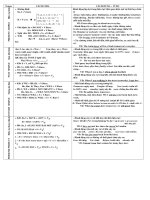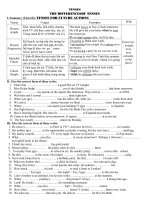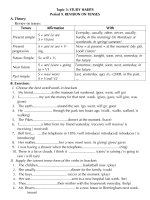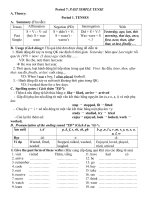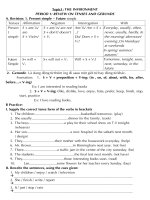Simple tenses
Bạn đang xem bản rút gọn của tài liệu. Xem và tải ngay bản đầy đủ của tài liệu tại đây (55.31 KB, 10 trang )
THE USE AND THE FORM OF TENSES
(CÔNG DỤNG VÀ CẤU TẠO CỦA THÌ)
SIMPLE PRESENT TENSE (HIỆN TẠI ĐƠN)
I/ USE (CÁCH DÙNG)
Thì Simple Present (Hiện tại đơn) được dùng để diễn tả:
1. Hành động quen thuộc,thói quen:
Thí dụ: I go to my English Club on Sundays.
(Tôi đi tới câu lạc bộ tiếng Anh của tôi vào những ngày Chủ Nhật)
2. Một chân lý tổng quát,sự thật hiển nhiên:
Thí dụ: The earth goes round the sun.
(Trái đất quay quanh mặt trời)
II/ FORM (CẤU TẠO)
1. AFFIRMATIVE SENTENCE (CÂU KHẲNG ĐỊNH)
2. NEGATIVE SENTENCE (CÂU PHỦ ĐỊNH)
3. QUESTION SENTENCE (CÂU NGHI VẤN)
4. NOTE (GHI CHÚ)
@ Khi chủ từ ở ngôi thứ ba số ít (He/She/It),động từ ở thì hiện tại phải thêm “s” hay “es”
Thí dụ: to work He
She works
It
@ Những động từ tận cùng “o,ch,sh,x,ss,z” được thêm “es” khi chủ từ ở ngôi thứ 3 số ít.
Thí dụ:
• to do He/she/It does (làm)
• to watch watches (xem)
• to fix fixes (sửa lại)
• to brush brushes (chải)
• to kiss kisses (hôn)
• to fizz fizzes (sủi bọt)
@ Những động từ tận cùng bằng “y” và có phụ âm đi trước ,ta đổi “y” ra “ies” khi chủ từ ở
ngôi thứ 3 số ít.
Thí dụ:
• to fly He/she/It flies (bay)
• to carry carries (mang,xách)
I / WE / YOU / THEY + VERB
HE / SHE / IT + VERB + S (ES)
I / WE / YOU / THEY + DON’T + VERB
HE / SHE / IT + DOESN’T + VERB
DO + I / WE / YOU / THEY + VERB ?
DOES + HE / SHE / IT + VERB ?
@ Cách phát âm chữ “S” hay : “ES” của ngôi thứ ba số ít
• Được đọc là /s/ khi theo sau âm /p,t,k,f/
Thí dụ: looks,stops.....
• Được đọc là /iz/ khi theo sau âm /s,dj ,tS,z,j/
Thí dụ: misses,watches .....
• Được đọc là /z/ khi theo sau tất cả những âm còn lại
Thí dụ: sees,begins .....
@ Thì hiện tại của động từ to be
@ Một số trạng từ và cụm trạng từ đi kèm với thì hiện tại đơn:
1. always ; luôn luôn
2. usually : thường thường
3. often : thường hay
4. sometimes = occasionally : thỉnh thoảng
5. occasionally : đôi khi
6. seldom = scarely : ít khi
7. rarely : hiếm khi
8. every day / week / month ..... : mỗi ngày / tuần / tháng .....
9. on Mondays / Tuesday ..... : vào những ngày thứ Hai,thứ Ba .....
10. once a week : mỗi tuần một lần
I + AM
HE / SHE / IT + IS
WE / YOU / THEY + ARE
I + AM NOT
HE / SHE / IT + ISN’T
WE / YOU / THEY + AREN’T
AM + I ?
IS + HE / SHE / IT ?
ARE + WE / YOU / THEY ?
EXERCISES ON TENSES
Put the verbs in the simple present tense
1. I (visit) my parents very often.
2. She (go) to school every day.
3. We always (go) to work by car.
4. We (watch) TV every night.
5. Peter (walk) to work every day.
6. The children usually (play) football every Saturday.
7. He (wash) his car every week.
8. They sometimes (go) to school by bus.
9. Mary (get) up at five o’clock every morning.
10. They occasionally (go) to the cinema on Fridays.
11. Tom (speak) English very well.
12. He always (want) to practise it.
13. The doorbell (ring) very often.
14. John (write) many letters to his parents.
15. The bus always (stop) there.
16. He usually (leave) his office at six o’clock,but this week he is working later.
17. He usually (get) up at about six o’clock.
18. You (know) where he (be) ?
19. I always (smoke) a lot when I am studying.
20. I (want) to tell you something.
21. You (take) a dog for a walk every day?
22. I always (not-listen to) the radio in the mornings.
23. She usually (buy) the food.
24. Miss White (not-teach) us English and French.
25. He (walk) to the office every day.
Complete the sentences with verbs given
give / ask / drink / love / listen / forget / drive / open / come /
learn / work / not snow / not like / go / start / see / swim
1. Children often ..... a lot of questions.
2. I always ..... classical music.
3. You always ..... my birthday.
4. They usually ..... coffee after their evening meal.
5. I sometimes ..... to work when the weather is cold.
6. She never ..... to me.
7. My parents usually ..... to our ouse on Sundays.
8. They often ..... two languages at school.
9. The village shop ..... at 8 in the morning.
10. We ..... her a diary every year.
11. She ..... very hard.
12. It usually ..... here in the winter.
13. I ..... a big breakfast every morning.
14. The film ..... very early.
15. He ..... every morning.
16. They always ..... the windows at night.
17. We often ..... our neighbours in the garden.
18. Mary ..... on holidays every year.
19. You ..... very fast.
20. These young children ..... very quickly.
Write sentences with words given
1. She/frequently/go
2. A lot of birds/seldom/fly
3. My younger sister/always/study
4. My father/rarely/watch
5. I/often/go
6. She/do/in the evenings
7. My mother/usually/wash
8. I/sometimes/listen to
9. My grandfather/often/tell
10. I/frequently/drink tea
11. Where/you/work/?
12. What/she/do/?
13. Where/live/?
14. What music/you/like/?
15. When/?
16. Why/me/?
17. What/the children/?
18. Who/teach/?
19. How/?
20. Why/the shop/close/?
Make sentences into WH-questons
1. The shop closes at 5 o’clock.
2. They go swimming every weekend.
3. She speaks good English.
4. The workers start their work at 9.
5. It rains a lot here in winter.
6. You drink a lot of tea for breakfast.
7. they do shopping on Saturdays with their parents.
8. Tony often plays golf at the weekends.
9. His friends visit him in hospital most evening.
10. She works very hard
Turn into question and negative forms:
1. The students take a piece of chalk.
2. The lawyers go to church every day.
3. These sailors go to work very late.
4. Miss Jane is a teacher.
5. Children play in the classroom.
6. Tom is an architect.
7. He sits on the floor.
THE USE AND THE FORM OF TENSES
(CÔNG DỤNG VÀ CẤU TẠO CỦA THÌ)
SIMPLE PAST TENSE (QUÁ KHỨ ĐƠN)
I/ USE (CÁCH DÙNG)
Thì Simple Past (quá khứ đơn) được dùng để diễn tả hành động:
1. Xảy ra tại 1 thời điểm qua khứ xác đònh.
Thí dụ: He bought some pencils yesterday.
(Anh ấy đã mua một số bút chì vào ngày hôm qua)
2. Xảy ra trong 1 khoảng thời gian và khoảng thời gian này đã kết thúc trong quá khứ.
Thí dụ: They worked in that factory for five years – from 1990 to 1995.
(Họ đã làm việc ở nhà máy đó trong 5 năm – từ 1990 đến 1995)
II/ FORM (CẤU TẠO)
1. AFFIRMATIVE SENTENCE (CÂU KHẲNG ĐỊNH)
Thí dụ:
• to work worked (làm việc)
• to watch watched (xem)
• to buy bought (mua)
• to see saw (thấy)
@ Cách thêm “-ED” của động tùe hợp qui tắc:
1. Thông thường chúng ta thêm “-ED” vào sau động từ:
Thí dụ:
watch watched
2. Động từ tận cùng bằng E câm,chúng ta chỉ thêm “-D"
Thí dụ:
to practise practised (thực hành)
to prepare prepared (chuẩn bò)
3. Động từ tận cùng “-Y” và trước “-Y” là 1 phụ âm,chúng ta đổi “-Y” thành “-I” rồi
thêm “-ED”
Thí dụ:
to fly flied (bay)
to carry carried (mang,xách)
4. Động từ 1 vần,tận cùng bằng 1 phụ âm trước có 1 nguyên âm,chúng ta gấp đôi phụ
âm trước khi thêm “-ED”
Thí dụ:
To stop stopped
To plan planned
5. Động từ 2 vần tận cùng bằng 1 phụ âm trước có 1 nguyên âm và vần thứ 2 được nhấn
trọng âm , chúng ta gấp đôi phụ âm trước khi thêm “-ED”
Thí dụ:
To omit omitted
@ Cách phát âm “-ED” của động từ thường ở thì quá khứ:
• “-ED” được đọc là /t/ khi theo sau 1 trong những âm /p,k,f,s,t∫,∫/
Thí dụ: looked,.....
SUBJECT + VERB + ED (hợp qui tắc)
SUBJECT + VERB (2) (bất qui tắc)


